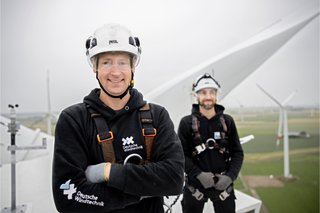Versatile, independent of turbine type, onshore and offshore
At Deutsche Windtechnik, each inspection request is assessed to determine which inspection method is the right one for the wind farm project. If the decision is made to use a drone, the technology offers many advantages, but one is particularly important: It saves time. Above all, wind turbine downtimes can be significantly reduced by using a drone. In addition, preparing the drone for use takes a relatively short time.
All three rotor blades in just one flight
While inspecting the rotor blades, the drone is either flown manually or semi-automatically by specially trained drone pilots, or it flies completely autonomously. For this purpose, they use software that automatically flies by all parts of the rotor blades. Deutsche Windtechnik provides this service onshore as well as offshore. It does not matter who the manufacturer of the wind turbine is for this. After the rotor blades have been positioned, the drone first orients itself using the rotor hub as a reference point, then uses the blades for orientation during further automatic flight using optical laser sensors. The inspection flight consists of twelve flight paths (four sides per rotor blade). This ensures that one hundred percent of the surface area of the rotor blades is documented.
"Depending on the inspection objective, different settings can be configured for the wind turbine. In addition, we have access to different hardware and mission control systems. This allows us to reduce the downtime to as little as 30 minutes. We can even complete tower and spot inspections in a matter of minutes."
Helge Brau - Project Manager Drone Inspection
In addition to simple rotor blade and tower inspections and inspections to detect individual occurences of damage (spot inspections), it is also possible to carry out lightning protection measurements using a drone. To measure lightning protection, a relatively high voltage is applied to the conductor cable. The electric field strength is measured by a device on the drone. The field strength is then used to determine the conductivity of the conductor cable of the lightning protection system in the rotor blade. Subsequently, the condition of the lightning protection system can be evaluated by analysing the signal.
Customised payload determines the image quality
Deutsche Windtechnik uses two different drones: a DJI M300 RTK or a DJI Mavic 3E. Depending on the type of drone and the objective of the inspection, the drone is equipped with a specially developed payload (for example sensors and camera). The payload is customised for image quality when inspecting the entire rotor blade from a greater distance. A smaller drone, on the other hand, is used for close-up photographs of damage, for example. The largest drone used by Deutsche Windtechnik can carry a payload of 2.7 kg, bringing its total weight to 9 kg. It can fly at speeds of up to 80 km/h.
Operators have long-term access to documents
The data collected by the drone consists of images and metadata, which are evaluated by an expert. Any damage can be precisely located and, if necessary, tracked for years, even after repairs. The positioning information is also used for creating repair instructions. A drone collects an average of approximately 600 images per wind turbine. After annotation (pre-selection), the image material goes through internal reviews. Finally, Deutsche Windtechnik sets up access for clients, enabling them to view the images in their original resolution. The corresponding expert opinions are also available there for the operator whenever they are needed.
Do you have any questions about this topic? Feel free to contact:
Aeneas Noordanus
Sales Manager Onshore & Offshore
a.noordanus@deutsche-windtechnik.com
+49 421 69 105 190



